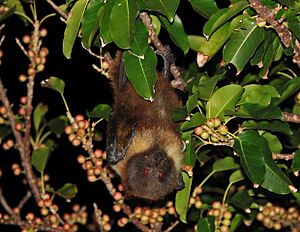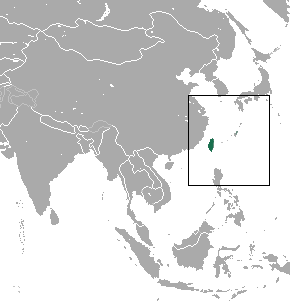Ryukyu flying fox facts for kids
The Ryukyu flying fox or Ryukyu fruit bat (Pteropus dasymallus) is a type of large bat. It lives in Japan, Taiwan, and some islands in the Philippines. These bats like to live in warm, dry forests and swamps. Sadly, their homes are shrinking, and some people hunt them for food. Because of this, the IUCN (International Union for Conservation of Nature) lists them as "Vulnerable", which means they need our help to survive.
Quick facts for kids Ryukyu flying fox |
|
|---|---|
 |
|
| Conservation status | |
| Scientific classification | |
| Genus: |
Pteropus
|
| Species: |
dasymallus
|
 |
|
| Ryukyu flying fox range | |
Contents
Naming the Ryukyu Flying Fox
A Dutch scientist named Coenraad Jacob Temminck first described this bat in 1825. He got the bats he studied from a businessman named Jan Cock Blomhoff.
The bat's scientific name, "dasymallus", comes from ancient Greek words. "Dasús" means hairy, and "mallós" means woolly. Temminck chose this name because the bat's fur is long and feels like wool.
There are five different types, or subspecies, of the Ryukyu flying fox. Each one lives on different islands:
- Daito fruit bat - P. d. daitoensis
- Erabu fruit bat - P. d. dasymallus
- Taiwanese fruit bat - P. d. formosus
- Orii's fruit bat - P. d. inopinatus
- Yaeyama fruit bat - P. d. yayeyamae
What Does It Look Like?
The Ryukyu flying fox is a medium-sized bat. Its wings can spread out to about 1.2 to 1.4 meters (about 4 to 4.6 feet) wide. It weighs between 400 and 500 grams (about 0.9 to 1.1 pounds). Its forearm, which is part of its wing, is about 140 millimeters (about 5.5 inches) long.
This bat's body is covered in long, thick hair, which makes it look very woolly. Its fur is reddish-brown, and it has a yellowish-white patch of fur on its neck. Its ears are small and pointed. They can be hard to see because of all the thick fur. The parts of its wings that help it fly are dark brown.
Daily Life and Diet
The Ryukyu flying fox mostly eats fruit. It enjoys fruits from at least 53 different kinds of plants. It also eats flowers from 20 plant species and leaves from 18 plant species. Sometimes, it even eats the bark of one type of tree. It has also been seen eating eight different kinds of insects.
The Chinese banyan tree is a very important food source for these bats all year long. These bats are also important for plants. They help pollinate a type of evergreen tree called Schima wallichii. They also pollinate a climbing vine called Mucuna macrocarpa.
Ryukyu flying foxes are nocturnal, which means they are active at night. During the day, they usually rest alone in trees. At night, they fly out to find food.
These bats help spread seeds. When they eat fruit, they later drop the seeds in their droppings (called guano). They can drop seeds far away from the parent trees, sometimes up to 1,833 meters (about 1.1 miles) away. This helps new plants grow in different places.
Where Do They Live?
The Ryukyu flying fox lives in Taiwan, Japan, and the Philippines. In Japan, you can find them on many islands, including the Ōsumi, Tokara, Okinawa, Miyako, Yaeyama, and Daitō Islands. In the Philippines, they live on Batan, Dalupiri, and Fuga islands.
Their favorite home is in forests. During the day, they rest in trees, either alone or in small groups.
Protecting the Ryukyu Flying Fox
The largest group of these bats is likely in the Philippines, and their numbers seem to be steady there. In Japan, there are thought to be over 5,000 bats. However, in Taiwan, the number of bats has gone down a lot.
These bats face several dangers. In some parts of the Philippines, people hunt them for food. On an island called Babuyan Claro, this bat is even considered a special meal. In Japan, the biggest problem is that their forest homes are being destroyed. Some bats also get caught in nets that farmers put up to protect their fruit crops. Others are accidentally hurt by power lines.
Overall, the number of Ryukyu flying foxes has been decreasing. But by 2008, their numbers seemed to stabilize a bit. Because of this, the IUCN changed their status from "Endangered" to "Vulnerable". This means they are still at risk, but not as much as before.
Ryukyu Flying Foxes and People
When Temminck first described these bats, he mentioned that they "devastate" fruit farms. In 2012, the Okinawa Prefecture in Japan started an investigation because of the damage these bats caused to orchards.
In 2013, a study in two villages estimated that flying foxes caused about 19 million yen (around $175,000 USD) in damage to citrus fruits each year. Because of this, many Japanese farmers think the Ryukyu flying fox is a pest. They believe the bats' numbers should be controlled, sometimes by removing them.


